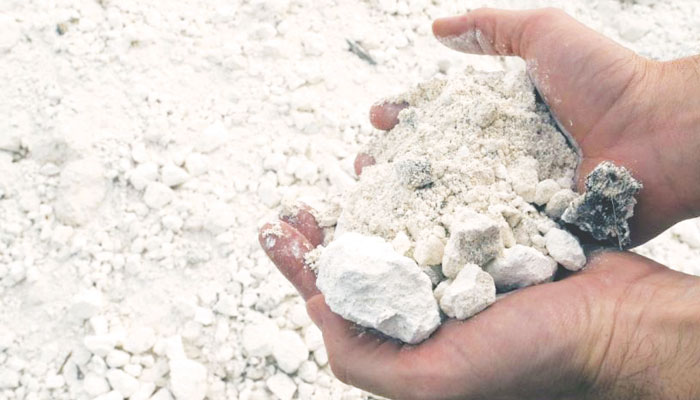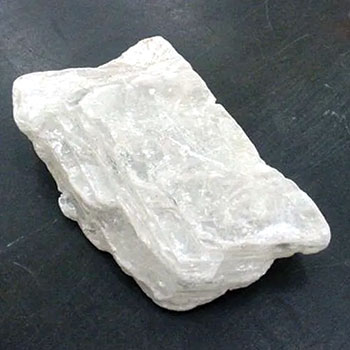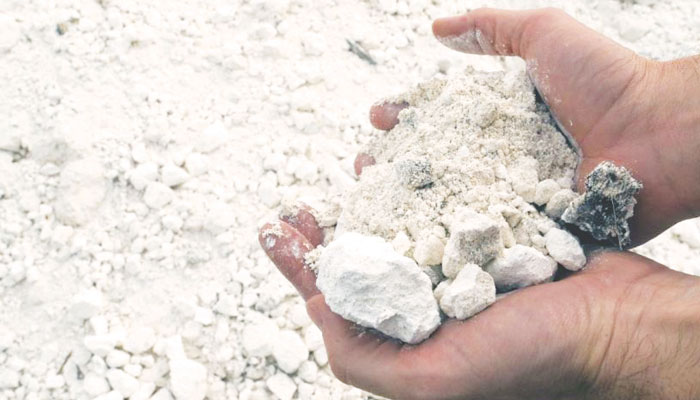
Gypsum, which is composed of hydrous calcium sulfate, holds a unique position among all non-metallic natural resources, as it has been shown to be beneficial from a medical point of view for centuries. For example, it has proved to be very useful as a protective wall after “surgery” in the case of bone disruption, while on the other hand, it has been discovered in modern times as a protective layer in underground oil and gas (petroleum) bearing structures. Due to this, its importance has become even more important.
Naturally occurring gypsum belongs to the evaporite mineral family, containing 32.5% calcium oxide, 46.6% silicon dioxide and 20.9% water. Evaporite minerals refer to all such natural compounds or minerals that form as a result of the evaporation process of seawater. Evaporites are called “evaporites”. Examples include rock salt (belaitton), gypsum, en-biderrite, and other compounds that typically form in parts of the ocean that are cut off from the open ocean and become basin-like structures, in which the sea Brine solution enters but returns very little.
It is as if a large amount of water remains stagnant in the basin, on which the temperature continues to affect the evaporation process, due to which the water evaporates and escapes into the atmosphere, and the salt and gypsum pens are concentrated on the floor of the basin. but the solutions accumulate on the basis of solubility i.e. the least soluble compounds are precipitated first. For example, the carbonate group and compounds with more soluble compounds are the last to be precipitated. For example carbides.
However, in a basin, gypsum first forms a “chemical precipitate” such that layers of gypsum are successively deposited on the basin floor with rock salt, resulting in chemical precipitates such as calcium carbonate, gypsum moderates. The amount of non-aqueous calcium sulfate (anhydrite) is created by the hydration of external pressure at depth (the highest depth is also 100-150 meters). That is, at this pressure, the inclusion of water on the non-aqueous calcium sulfate and the process of freezing. Aqueous calcium sulfate is formed which is called “gypsum” and its volume increases by about 35%.

Here it is to be kept in mind that there are two names of a mineral which come into existence by changing from each other after chemical reaction. That is why this method is called ‘Reversible Rotation’. The difference between the two is that when the gypsum-bearing layer undergoes hydration under pressure, water is incorporated, forming aqueous calcium sulfate, but when “gypsum” is d. When dehydration occurs, the water comes out and only calcium sulfate remains, which is called “an hydrate”. The only difference is in their hardness. Gypsum has two on the Mohs scale of hardness, but when the water is out, the hardness of “anhydrite” is about 2.5, about the hardness of a nail. It is 2.5.
For this reason, gypsum is easily scratched compared to anhydrite. That is, its powder easily gets on the nails, whereas in the case of anhydrite, the nails start to scratch. Most of the “gypsum” deposits found in the world have been formed by this type of process. Also, in desert and semi-desert regions, veins are found in the crust of weathered rocks in the form of gourds. These sulfuric acids are also formed in mixed water or by the action of soluble sulphides.
Sometimes these oxides are also present in zones or sulfide deposits, because in most phases when the sulfide ore contains pyrite, its precipitation increases the sulfuric acid content of the surface water. , so that acidified surface water “gypsum” deposits are commonly found associated with some other sulfates in the upper zones of rocks or primary ore zones.
The stability of various salts during the evaporation process has been estimated either experimentally or from clinical chemistry data, confirming that calcium sulfate exists in two forms, the hydrated mineral (gypsum) and the unhydrated (N hydrite) occurs as In both cases, the high superposition temperature, solubility, and vapor pressure of the solute dominate.
If only calcium sulfate is present in the solution, precipitation of “anhydrate” occurs at 60°C, while gypsum precipitates at 42°C. An example of this is the deposits in the Persian Gulf where anhydrite formation takes place at 80°C.
While in open water where the temperature is 42 degrees Celsius, gypsum is precipitated. Gypsum has an unusual feature in that its total solubility peaks at 37-38°C and then suddenly decreases and falls rapidly thereafter. Rapid decomposition occurs at 107°C. Thermograph confirms the fact that when gypsum is heated under atmospheric pressure, water starts to lose at 80-90 degrees Celsius while at 120-140 degrees it is completely dehydrated. Formation of hydrate (Hemihydrate) takes place.
Plaster called gypsum or plaster of Paris is an adhesive, which has the property of binding bone fractures in the correct position. While in modern times, the fact has also been revealed that gypsum is present as a protective layer at the top of the oil and gas bearing structure, because it consists of unconnected pores, due to which the oil And the gas, which has a low density, tends to rise, but the gypsum layer does not allow it to escape into the atmosphere.
Thus, a profitable oil and gas reservoir is stored in underground reservoir rocks. Gypsum is found throughout the geological era and around the world. Gypsum deposits are also widespread in Pakistan. Its current production is mostly sourced from Dawood Khel, Khewra and Dandot. Gypsum is used in large quantities in the manufacture of fertilizers, cement and rubber industry.
setTimeout(function(){
!function(f,b,e,v,n,t,s)
{if(f.fbq)return;n=f.fbq=function(){n.callMethod?
n.callMethod.apply(n,arguments):n.queue.push(arguments)};
if(!f._fbq)f._fbq=n;n.push=n;n.loaded=!0;n.version=’2.0′;
n.queue=[];t=b.createElement(e);t.async=!0;
t.src=v;s=b.getElementsByTagName(e)[0];
s.parentNode.insertBefore(t,s)}(window,document,’script’,
‘https://connect.facebook.net/en_US/fbevents.js’);
fbq(‘init’, ‘836181349842357’);
fbq(‘track’, ‘PageView’);
}, 6000);
/*setTimeout(function(){
(function (d, s, id) {
var js, fjs = d.getElementsByTagName(s)[0];
if (d.getElementById(id)) return;
js = d.createElement(s);
js.id = id;
js.src = “//connect.facebook.net/en_US/sdk.js#xfbml=1&version=v2.11&appId=580305968816694”;
fjs.parentNode.insertBefore(js, fjs);
}(document, ‘script’, ‘facebook-jssdk’));
}, 4000);*/



